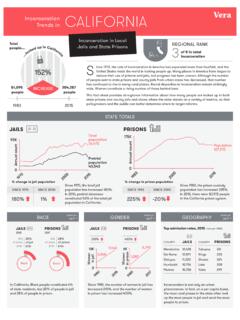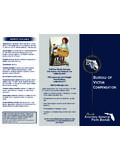Transcription of Screening for Human Trafficking - Vera Institute of Justice
1 1 NCJ #246713 The Vera Institute is an independent nonprofit that combines expertise in research, demonstration projects, and technical assistance to help leaders in government and civil society improve the systems people rely on for Justice and safety. Tool validation and implementation evaluation research was supported by the National Institute of Justice (Award No. 2011-MU-MU-0066.) Points of view or opinions in this document are those of the authors and do not represent the official position or policies of the United States Department of Justice . Screening for Human Trafficking Guidelines for Administering the Trafficking Victim Identification Tool (TVIT) JUNE 2014 Vera Institute of Justice 233 Broadway, 12th floor New York, New York 10279 2 Table of Contents About this manual.
2 3 The purpose and limitations of Screening .. 3 Tips for Conducting Interviews .. 4 Setting up the interview .. 4 Developing trust and demonstrating respect during interviews .. 5 Maintaining confidentiality .. 5 Understanding the effects of trauma and victimization .. 6 Additional considerations for law enforcement .. 7 Some considerations when asking these questions .. 8 Frequently Asked Questions .. 9 Advice on Using the Trafficking Victim Identification Tool (TVIT) .. 11 Trafficking Victim Identification Tool (TVIT) Long 13 Trafficking Victim Identification Tool (TVIT) Short Version .. 25 Training and Other 31 Definitions of Human Trafficking in the United States.
3 35 3 About this manual This manual is intended primarily for victim service agency staff and other social service providers, who will administer the Trafficking Victim Identification Tool (TVIT) to clients who are potential Trafficking victims . Law enforcement, health care and shelter workers will also find it helpful in improving Trafficking victim identification, especially in conjunction with appropriate training or mentoring. The manual content is based on results of research conducted by the Vera Institute of Justice , which collaborated with leading legal and victim services agencies in the United States, to produce the validated Screening tool and best practices for identifying trafficked persons, and on other expert sources in government and non-governmental Vera s research found that the TVIT instrument is highly reliable in predicting both labor and sex Trafficking in women and men and among foreign- and born victims .
4 The Screening tool can be used in its short version (consisting of 16 core questions, plus questions specific to migration for the foreign-born) without loss of predictive ability, or in its longer form, depending upon the situation and purpose of Screening . As with any kind of information gathering from victims of crime, it is essential that Screening for Trafficking be done with care. The purpose and limitations of Screening Screening questions can help agency staff to identify victims of Human Trafficking and help Trafficking victims obtain the protection and services they need. Before using the TVIT with persons who may be victims of Human Trafficking , the victim s personal safety and comfort should be assured.
5 Screening tool users should make every effort to establish trust and rapport before asking difficult questions that focus on traumatic experiences and other facts. Before Screening , users should also be prepared to draw upon the expertise of local legal and medical staff and to refer identified Trafficking victims to appropriate housing, health and social services in their area. While this user guide provides essential tips for effective Screening with the TVIT, the tool is a complement to, not a substitute for, specialized training in Human Trafficking , good professional practices and victim-centered services. The TVIT has been found to be valid and reliable in identifying victims of sex and labor Trafficking .
6 However, caution must be exercised in relying too heavily on the results of the Screening tool alone, as negative responses to the questions do not definitively preclude the possibility of victimization. Respondents whose answers initially indicate a lack of victimization may instead be demonstrating reasonable fear or forgetfulness as a symptom of trauma. As such, for the best outcomes, questions may have to be asked at a time when the potential victim trusts the interviewer and is ready to respond. The Screening tool should be used to guide interviews with potential victims , not to eliminate or deny potential victims access to needed services and legal protections.
7 The best practices in this manual will help to ensure appropriate and successful use of the Screening tool. Please consult state and federal definitions of Human Trafficking (Appendix B, p. x) to use alongside the Screening tool. 1 The full research report is available from the National Institute of Justice , and from the Vera Institute of Justice 4 Tips for Conducting Interviews The effectiveness of Screening for Trafficking victimization depends on allaying fear, building rapport and asking questions in an appropriate manner. Interviewers should be comfortable working with Trafficking victims , sensitive to their special needs, and aware that they are likely to be suffering the impacts of traumatic experiences.
8 Setting up the interview The setting in which an interview takes place can be as important as the questions that are asked. Trafficking victims have often been held in servitude through threats of harm and fear of their arrest or deportation by police and immigration authorities. It is crucial to establish a safe space to help victims feel more comfortable and protected. To help allay victims fears from the onset of an interview, the following techniques have proven effective: Before conducting a Screening , service providers should fulfill some basic needs, such as providing food, clothing, medical care or assurance of at least temporary shelter, if necessary.
9 It may be difficult for a victim to engage in an interview unless these immediate needs for physical comfort and safety are met. Hold the interview in a non-threatening and comfortable location. Provide the victim with food and drink, and incidentals including tissues, regular breaks, and a place where the victim can gain their composure if the interview causes distress. Never interview the victim within sight of the trafficker. If the victim arrives with a person exhibiting controlling behavior, talk to the victim in private. This person may be the trafficker or someone working for the trafficker. Maintain a professional, but friendly, attitude and appearance.
10 Law enforcement agents should dress in civilian clothes and make sure no weapons are in view. Others should consider dressing in casual clothing, especially when visiting agricultural labor camps to reach out to potential victims . Dressing in uniforms and other formal attire may create fears that interviewers are from immigration or other enforcement agencies. Be honest at the beginning about the purpose and duration of the Screening . Describe the victim s rights, the interview process, and the roles of everyone involved. Employ competent, trustworthy interpreters if the victim s first language is not English. Competent interpreters ask questions using the same wording as the screener and answer as fully as the victim.













